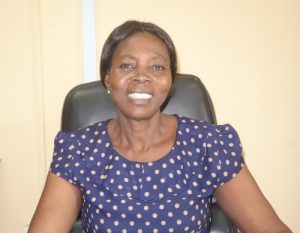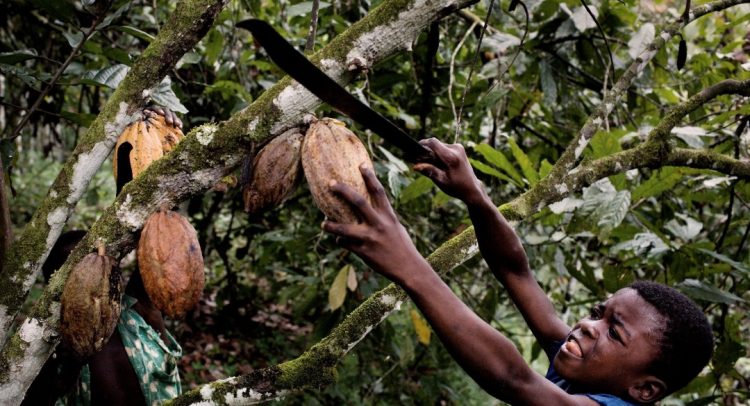A child harvesting cocoa
The Abonse cocoa farming community, located in the Sefwi Wiawso cocoa growing district of the newly-created Western North Region, has found a perfect replacement for the use of children in hazardous farming activities while creating jobs for the youth.
In the past, cocoa farmers in the community engaged children in hazardous farming tasks like pruning and breaking of the cocoa pods with sharp tools with no protection, which deprived the children of their education and exposed them to health risks. But the situation has changed with the introduction of the Community Service Groups (CSG) a few years ago by the International Cocoa Initiative (ICI) after a series of engagements with the community on how to end the practice.
“The vision of the group is to help stop the use of children as labourers in farming activities that are hazardous to their health,” says Joseph Agyei Koranteng, chairman of the Abonse Community Service Group, adding, “Our core work is to weed farms for farmers and to do it at a cheaper price, so the children can focus on their education and be protected from harm.”

Elizabeth Akanbombire
The practice of children working on cocoa farms is often a natural way of life for majority of cocoa farmers who, for varied reasons, want to train their children in cocoa farming and at the same time use them as farm hands in order to reduce labour costs.
These activities, when done under adult supervision outside school hours or during school holidays for a few hours, cannot be considered as child labour, however, work that deprives children of their childhood, their potential and their dignity and work that is mentally, physically, socially and/or morally harmful to children, is what is termed child labour.
According to the NORC Report: ‘Assessing Progress in Reducing Child Labour in Cocoa Production in Cocoa Growing Areas of Cote d’Ivoire and Ghana’, there are 61 million child labourers in Africa’s agriculture sector; out of which some1.56 million child labourers are in cocoa production in Cote d’Ivoire and Ghana alone.

Andrew Addoquaye Tagoe
Thus, groups like the CSG are crucial in helping to eliminate child labour in cocoa farming areas as it provides labour at a cheaper cost to cocoa farmers.
“We received training on farm sanitation including weeding, pruning, and moss removal from cocoa trees. We then apply these skills to assist cocoa farmers, reducing the need to use children as labour,” Mr. Koranteng, who has led the group for a few years, notes.
He says the activities of the group have also helped to maximise the cultivation of the cash crop since they started operating in the community.
“Our farmers used to suffer in the cultivation of their lands, they left a lot of work in the bush, especially in the communities where we cultivate cocoa, but with the coming of the Community Service Groups, it has helped to facilitate the production of the cash crop,” he adds.
Mr. Koranteng says the group, which currently has about 13 members, has through their activities generated enough income to meet their operational needs and welfare.
“So, for instance, when labourers weed a farm, GH¢20 is the fee charged but when you use the CSG we charge GH¢17 per person, and this is how we breakdown the money, GH¢2 is allocated for food for each of the team members then the GH¢5 is allocated as our pocket money for us who go to weed and the GH¢10 is for investing into the group.
“Last year, we did a lot of work and were able to save GH¢2,500 at the bank. Truth be told, at the end of the year when we were delivering account, we realised the enormous support given to us by the ICI team which we are still benefiting from,” Mr. Koranteng narrates.
ICI Project Manager for Innovation Projects, Andrews Asamoah, explaining the context within which the Community Service Groups fall, states that the project was part of interventions aimed at reducing the incidence of child labour at the community level.
“One of the key actions that we undertook is to help the communities develop a community action plan to localise interventions that will help reduce the incidence of child labour at the community level.
“We came up with this innovation of the Community Service Groups. This concept brings together the youth in the community, trains them, and then they provide equally the same service as normal labourers but then at a cheaper cost,” Mr. Asmaoh explains.
Mr. Asamoah adds that ICI also sets the group up by supplying the materials they would need to provide labour for the cocoa farmers but then the money they generate form the trade is used as a source of income for the members of the group.
“Here they can decide to save the money and use it as a source of income for the youth who probably would not have gotten a service or employment to cater for themselves,” he adds.
He says the idea was built on the ‘Nogua’ concept of community labour and has come to remove the bottleneck of labour availability and cost.
“The group came in to eliminate this aspect of engaging the children in hazardous tasks and paying them at a cheaper rate so now you have no excuse to say that we do not have labour in the community or that the labour in the community is expensive because through this initiative the farmers have access to cheap labour and labour at any point in time,” he states.
Impact
The project, which started with some 38 communities, has expanded to reach over 50 communities, says Mr. Asamoah.
He adds that the project has been of great benefit to communities involved, saying that it has created employment for the youth and provided a sustainable income generation activity for them.
“It has been difficult to get them to work because most of them would not want to go and do the work on credit but the group has come to give some sort of employment in a way because it is helping them grow and expand their farms and as well make money for themselves,” he explains.
He avers that one of the key benefits of the CSG is that the groups are able to raise funds to support themselves as well as undertake certain community projects. “In one of the communities, the CSG came together to help build staff accommodation for teachers of a school,” he says.
Mr. Asamoah further explains that ICI in addition to the CSG has initiated income generating activities for families in cocoa growing communities like gari making, rice production, and palm oil extraction.
“We don’t depend on one intervention but we have multiple interventions working together to address the issue of child labour by solving the issue of poverty.
“The process has been very useful; we have had positive results. We recently did a study on the intervention and the outcome was very positive.
Lives have been touched through other interventions like school infrastructure because most of the communities do not have schools,” Mr. Asamoah explains, adding, “Child labour at where we work has significantly reduced.”
Progress
Head of the Child Labour Unit of the Department of Labour, Elizabeth Akanbombire, says tackling child labour in all forms is better achieved through the child protection committees that the unit, with support from its partners, has been established in communities to find local solutions to the phenomenon.
“There is a saying that one child in employment is one adult out of employment, so if the Community Service Groups are there and are ready to work, it helps the children stay out of work and they can go to school.
“Though we know that employers usually want to use the children because they are cheap labour, if the service groups are ready and, in the community, and we are able to insist that this is what should take place, it will relieve the children to be able to go to school and learn a skill that they need for their future life,” she adds.
Madam Akanbombire indicates that there has been an overall progress in efforts towards the elimination of child labour, “there is no community that does not have knowledge about child labour or they don’t know what to do. They are all aware of it, but the problem is getting attitude and behaviours to change. So, for me, I will say that we have made progress, people now understand the issues but what is lacking is some people are still not changing.”
Way Forward
Deputy General Secretary of the General Agricultural Workers Union (GAWU), Andrews Tagoe, believes that one of the key ways to sustainably solve the problem is to keep the children in school after they have been taken out of child labour.
He says children re-enter employment because adults are not able to pay for the work if an adult is doing it, or there is an absence of labour.
“So, anytime a child is removed from child labour, the most sustainable way is to find an adult to replace that child so that the demand side of child labour will reduce so that the child is not likely to go back.
“The second thing that happens is that everything must be in the best interest of the child, so when you take the child from child labour you must know where you are taking the child to a safe place and the safety is a pregnant institution with a lot of things,” he explains.
GAWU thinks that addressing child labour in a sustainable way depends on empowering community systems to respond and one of it is replacing child labour with Community Service Groups.
By Jamila Akweley Okertchiri


